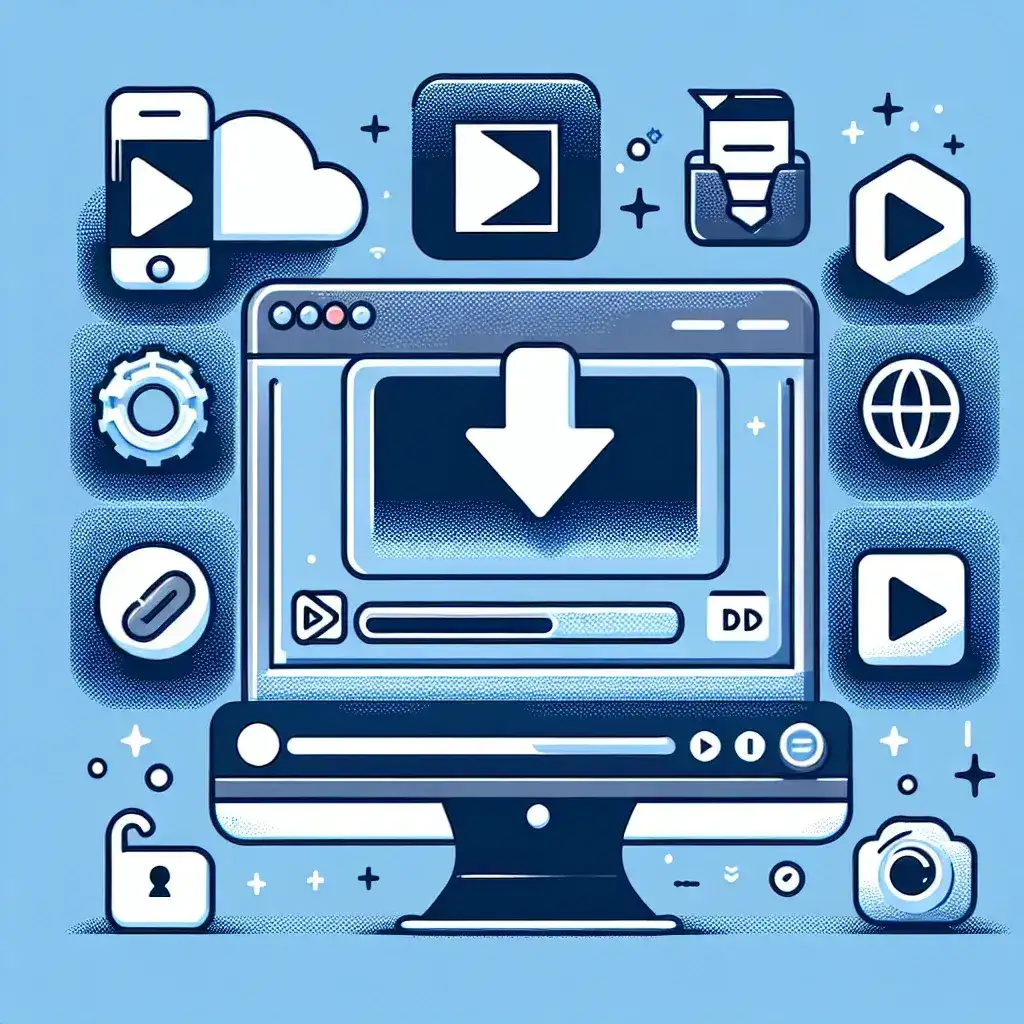Understanding the Need for Offline Video Access
In today’s digital landscape, video content has become an integral part of our daily lives. Whether for educational purposes, entertainment, or professional development, millions of users worldwide rely on video platforms to access valuable content. However, internet connectivity isn’t always reliable, and data limitations can restrict our ability to stream videos whenever we need them. This reality has created a growing demand for offline video access solutions.
The ability to download videos for offline viewing addresses several practical concerns. Students preparing for exams might need to access educational tutorials without internet connectivity. Travelers facing limited data plans or poor network coverage benefit from having entertainment content readily available. Content creators often require offline access to reference materials or inspiration sources. These scenarios highlight the legitimate need for Youtube video download capabilities.
Legal Framework and Ethical Considerations
Before exploring download methods, understanding the legal landscape surrounding video downloads is crucial. Platform terms of service typically restrict unauthorized downloading of content, emphasizing the importance of respecting intellectual property rights. However, many jurisdictions recognize fair use provisions that allow personal, non-commercial use of downloaded content.
The key principle revolves around personal use versus redistribution. Downloading videos for personal viewing, educational purposes, or backup copies generally falls within acceptable use parameters. However, redistributing downloaded content, using it for commercial purposes, or circumventing monetization systems violates both platform policies and copyright laws.
Content creators invest significant time and resources in producing videos, often relying on platform monetization for their livelihood. Respecting their work means acknowledging their rights while finding legitimate ways to access content offline when necessary.
Platform Policies and User Agreements
Major video platforms maintain strict policies regarding content downloading. These policies exist to protect creator rights, maintain revenue streams, and ensure content security. Users accepting platform terms agree to abide by these restrictions, making it essential to understand the boundaries of acceptable use.
Some platforms offer official offline viewing features through their premium services. These legitimate options provide a balance between user convenience and creator protection, often including offline access as part of subscription packages.
Technical Methods for Video Downloading
Several technical approaches enable video downloading, each with distinct advantages and limitations. Understanding these methods helps users choose the most appropriate solution for their specific needs.
Browser-Based Solutions
Browser extensions represent one of the most accessible downloading methods. These tools integrate directly with web browsers, providing download buttons or options when viewing videos. The convenience factor makes browser extensions popular among casual users who occasionally need offline access.
However, browser-based solutions often face limitations due to platform security measures. Regular updates to video platforms can temporarily disable extension functionality, requiring users to wait for compatibility updates. Additionally, browser extensions may have limited format options or quality settings compared to dedicated software.
Dedicated Software Applications
Standalone applications offer more robust downloading capabilities compared to browser extensions. These programs typically provide advanced features such as batch downloading, format conversion, quality selection, and playlist processing. Professional users or those with extensive downloading needs often prefer dedicated software for its reliability and feature set.
Desktop applications generally offer better performance and stability than web-based alternatives. They can handle larger files, provide more format options, and often include additional tools for video management and organization.
Command-Line Tools
Technical users may prefer command-line interfaces for their flexibility and automation capabilities. These tools offer precise control over download parameters, enabling custom workflows and batch processing. While requiring more technical knowledge, command-line solutions provide unmatched customization options.
Advanced users can integrate command-line tools into scripts or automated systems, making them ideal for research purposes, content archival, or educational institutions managing large video libraries.
Quality Considerations and Format Selection
Video quality significantly impacts both file size and viewing experience. Understanding quality options helps users make informed decisions based on their intended use and storage constraints.
Resolution Standards
Modern video platforms offer multiple resolution options, from standard definition to ultra-high definition. Higher resolutions provide better visual quality but require more storage space and processing power. Users must balance quality requirements with practical limitations such as device capabilities and available storage.
For mobile viewing, moderate resolutions often provide adequate quality while conserving storage space. Desktop viewing or projection scenarios may benefit from higher resolutions, particularly for educational or professional content where detail clarity matters.
Audio Quality Factors
Audio quality considerations extend beyond simple bitrate numbers. Music videos, educational content, and podcasts each have different audio requirements. Understanding these needs helps optimize downloads for specific content types.
Some downloading tools offer audio-only extraction options, useful for podcast content or music where video components aren’t necessary. This approach significantly reduces file sizes while maintaining audio quality.
Storage Management and Organization
Effective storage management becomes crucial when building offline video libraries. Without proper organization, downloaded content can quickly become unwieldy and difficult to navigate.
File Naming Conventions
Consistent file naming helps maintain organized libraries over time. Including relevant information such as creator names, upload dates, or content categories in filenames facilitates easier searching and sorting. Automated tools can often apply naming conventions during the download process.
Consider future accessibility when establishing naming conventions. Names that make sense today should remain clear and useful months or years later when revisiting archived content.
Folder Structure Strategies
Logical folder hierarchies prevent content from becoming lost in disorganized directories. Organizing by creator, subject matter, date, or content type provides multiple approaches depending on personal preferences and use cases.
Educational content might benefit from subject-based organization, while entertainment content could be grouped by creator or genre. The key lies in choosing a system that matches your access patterns and sticking to it consistently.
Device Compatibility and Playback Considerations
Downloaded videos must remain accessible across various devices and platforms. Format compatibility ensures content remains viewable regardless of the playback device or software changes over time.
Universal Format Standards
Certain video formats enjoy broader compatibility across devices and platforms. Choosing widely-supported formats reduces the likelihood of playback issues when switching between devices or sharing content with others.
However, universal compatibility sometimes comes at the cost of file size efficiency or quality. Users must weigh compatibility benefits against storage and quality considerations based on their specific needs.
Mobile Device Optimization
Mobile playback introduces additional considerations such as battery life, processing capabilities, and screen size optimization. Videos optimized for mobile viewing often use different encoding parameters than desktop-optimized content.
Some downloading tools offer mobile-specific presets that balance quality, file size, and battery efficiency for optimal mobile viewing experiences.
Security and Privacy Implications
Video downloading activities carry potential security and privacy risks that users should understand and mitigate. Third-party downloading tools may introduce malware, data collection concerns, or other security vulnerabilities.
Safe Downloading Practices
Selecting reputable downloading tools from trusted sources reduces security risks. Reading user reviews, checking software certifications, and avoiding suspicious download sites helps maintain system security.
Regular software updates ensure downloading tools remain secure and functional as platforms evolve. Outdated software may contain security vulnerabilities or compatibility issues that compromise user safety.
According to recent cybersecurity research from SANS Institute, users should exercise caution when downloading third-party software and always verify source authenticity before installation.
Privacy Protection Measures
Some downloading activities may leave traces in browser history, temporary files, or software logs. Users concerned about privacy should understand what information downloading tools collect and how to minimize their digital footprint.
Using private browsing modes, clearing temporary files, and reviewing software privacy policies helps protect personal information during downloading activities.
Educational and Professional Applications
Video downloading serves legitimate purposes in educational and professional contexts. Understanding these applications helps justify offline access needs while respecting content creator rights.
Academic Research and Study
Researchers and students often require offline access to video content for detailed analysis, note-taking, or citation purposes. Educational institutions may need to archive content for curriculum development or provide offline access in areas with limited connectivity.
Many educational videos contain valuable information that benefits from repeated viewing and detailed study. Offline access enables students to review complex concepts at their own pace without internet connectivity constraints.
Professional Development and Training
Professional training videos, conference presentations, and skill development content often warrant offline access for convenient review and reference. Professionals traveling frequently or working in areas with unreliable internet connectivity benefit from having training materials readily available.
Some industries require offline access to training materials for compliance or certification purposes. Understanding legitimate professional use cases helps justify downloading activities within appropriate legal and ethical boundaries.
Content Creator Perspectives and Monetization
Content creators invest significant time, effort, and resources in producing videos. Understanding their perspectives on downloading helps users make ethical decisions while accessing content offline.
Creator Revenue Models
Most video creators rely on platform monetization systems that depend on online viewing metrics. Ad revenue, subscription income, and engagement statistics directly impact creator earnings. Downloaded content consumed offline doesn’t contribute to these revenue streams.
Supporting creators through official channels such as memberships, merchandise purchases, or direct donations helps offset the revenue impact of offline viewing. Many creators appreciate when users find ways to support their work while accessing content offline.
Community Guidelines and Creator Policies
Individual creators may have specific policies regarding their content use and distribution. Some creators explicitly permit downloading for personal use, while others prefer all viewing to occur through official platforms.
Respecting creator preferences demonstrates ethical consumption of their content. When in doubt, reaching out to creators directly can clarify their stance on offline access to their videos.
Future Trends and Technology Developments
The landscape of video downloading continues evolving as technology advances and platform policies change. Understanding emerging trends helps users prepare for future developments in offline video access.
Platform Innovation and Offline Features
Video platforms increasingly recognize user demand for offline access, leading to official offline viewing features in premium services. These legitimate options provide a compromise between user convenience and creator protection.
Future developments may include improved offline synchronization, better quality options, and expanded content availability through official channels. Users benefit from staying informed about these legitimate alternatives to third-party downloading tools.
Technology Standards and Compatibility
Evolving video standards, compression technologies, and device capabilities continue shaping the downloading landscape. New formats may offer better quality-to-size ratios, while emerging devices introduce new compatibility considerations.
According to industry analysis from Statista, mobile video consumption continues growing, driving demand for efficient offline viewing solutions optimized for mobile devices.
Staying current with technology trends helps users make informed decisions about downloading tools and format choices that will remain relevant over time.
Troubleshooting Common Issues
Video downloading often involves technical challenges that users should be prepared to address. Understanding common issues and their solutions improves the overall downloading experience.
Download Failures and Errors
Network connectivity issues, platform security measures, and software compatibility problems can cause download failures. Identifying the root cause helps determine appropriate solutions.
Common troubleshooting steps include checking internet connectivity, updating downloading software, clearing browser cache, and trying alternative download methods. Persistent issues may require switching to different tools or adjusting download parameters.
Quality and Format Problems
Downloaded videos may occasionally suffer from quality issues, format incompatibility, or playback problems. Understanding these issues helps users adjust their downloading approach for better results.
Testing different quality settings, trying alternative formats, and using video conversion tools can resolve many playback issues. Some problems may require experimenting with different downloading software to find compatible solutions.
Best Practices and Recommendations
Successful video downloading requires following established best practices that maximize efficiency while minimizing risks and ethical concerns.
Responsible Usage Guidelines
Responsible downloading involves respecting creator rights, following platform policies, and using downloaded content appropriately. This includes avoiding redistribution, respecting copyright limitations, and supporting creators through legitimate channels.
Users should also consider the impact of their downloading activities on platform ecosystems and creator communities. Making ethical choices helps preserve the sustainability of content creation while meeting legitimate offline access needs.
Technical Optimization Strategies
Optimizing downloading processes improves efficiency and reduces potential issues. This includes choosing appropriate quality settings, organizing downloaded content effectively, and maintaining updated software.
Regular maintenance of downloading tools and organized storage systems ensures long-term accessibility of archived content. Users benefit from establishing consistent workflows that can be maintained over time.
Alternative Solutions and Official Options
Before resorting to third-party downloading tools, users should explore official offline viewing options provided by video platforms. These legitimate alternatives often provide the best balance between convenience and ethical content consumption.
Premium Service Features
Many platforms offer offline viewing capabilities as part of their premium subscription services. These official options provide legal offline access while supporting creators and platforms financially.
Premium features often include additional benefits such as ad-free viewing, exclusive content, and enhanced quality options. Evaluating the total value proposition helps determine whether premium subscriptions represent better alternatives to third-party downloading.
Creator-Approved Methods
Some content creators provide official download options through their own websites, direct sales, or approved third-party services. These creator-approved methods ensure proper compensation while providing legitimate offline access.
Supporting creators through their preferred distribution channels demonstrates respect for their work while meeting offline viewing needs. Many creators appreciate when users choose official channels over unauthorized downloading methods.
Impact on Digital Content Ecosystem
Video downloading activities affect the broader digital content ecosystem in various ways. Understanding these impacts helps users make informed decisions about their consumption habits.
Economic Considerations
The digital content economy relies on various revenue streams that may be affected by offline viewing patterns. Understanding these economic relationships helps users appreciate the importance of supporting creators and platforms appropriately.
Balancing personal convenience with ecosystem sustainability requires thoughtful consideration of how downloading activities impact content creators, platforms, and the overall digital economy.
Innovation and Development
User demand for offline access drives innovation in both official platform features and third-party solutions. This dynamic relationship continues shaping the evolution of digital content consumption.
Constructive feedback to platforms about offline viewing needs can influence the development of official features that benefit both users and creators. Engaging with platforms through proper channels helps communicate legitimate use cases for offline access.





Leave a Reply